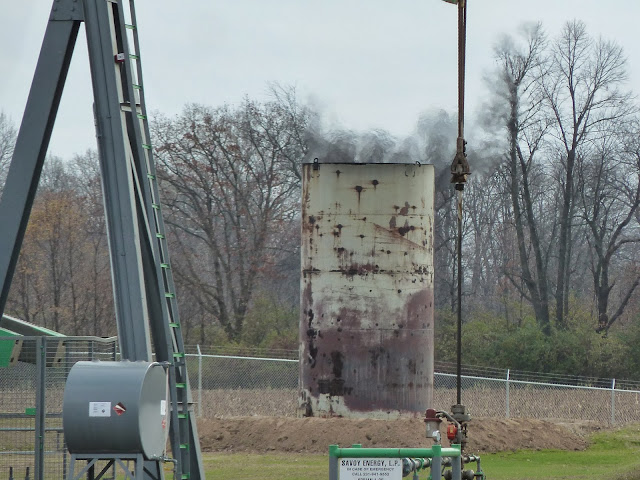According to the environmental health specialist James Argo, one regular component of flare fumes, benzene "will be present in enough concentration to pose a measurable risk to inhabitants out to 5 km from the flare". I indicate this radius in the below picture:
The flare on Witt Farm and the 5km radius around the flare in which to expect health impacts due to benzene alone. At least 15,000 people live within this circle.
Here are a few other excerpts from a report James Argo wrote for the Canadian environmental group Save Our Seas and Shores (Argo 2001):
- "A flare is a device for disposing of waste gas and oil [and co-produced sea-water] very cheaply by burning the organic material in an open, uncontrolled, manner at an elevation above the ground varying from 15 to 75 or more m.. The elevation is to disperse the combustion products and throw them away from the work site."
- "Flares are an unreported source of greenhouse gases. Flaring emissions do not appear in National Pollutant Release Inventory from Environment Canada nor Toxic Release Inventory in the US."
- "Flares are an unreported source of dioxins."
- "A poorly operating flare is a travesty against the entire biosphere within up to a 30km radius. It is axiomatic that where a flare is smoking no one should be downwind."
- "The result is that an elevated risk for cancer may be present in the first 2.5 to 5 km from the flare. Residents in this zone have the potential to be affected by benzene exposure as described below. This concentration of benzene is below the odor threshold."
- "Increased morbidity and elevated risk of leukemia is everywhere possible for residents within 5 km under these conditions. Those most at risk of long-term health effects are persons under age 30."
Sources:
Argo J. UNHEALTHY EFFECTS OF UPSTREAM OIL AND GAS FLARING [Internet]. Sydney, NS, Canada: SAVE OUR SEAS and SHORES (SOSS). Available from: https://wassmer.org/Adrian/soss-oil-and-gas-flaring.pdf
Amodio M, de Gennaro G, Marzocca A, Trizio L, Tutino M. Assessment of Impacts Produced by Anthropogenic Sources in a Little City near an Important Industrial Area (Modugno, Southern Italy). The Scientific World Journal [Internet].2013:10. Available from: http://dx.doi.org/10.1155/2013/150397










